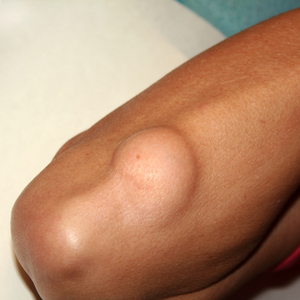
What is a liposarcoma?
A liposarcoma or lipomatous tumour is a malignant cancer of the fatty tissue (neoplasia), which occurs more frequently in men over 50 years of age. Liposarcomas account for between 15 and 20 per cent of all malignant tumours of the soft tissues, i.e. all non-bony structures of the human body, and form mainly on the thighs, on the back and behind the peritoneum (retroperitoneum). Liposarcoma does not usually cause pain. Between 82 and 86 percent of all Caucasians develop liposarcoma.
How does a liposarcoma develop and what are its characteristics?
Doctors still disagree about the causes that contribute to the development of a liposarcoma. However, they suspect that a liposarcoma can be traced back to the alteration of some genes that are present in the fat cells. However, prior radiation to treat a previous cancer, genetic factors such as neurofibromatosis and/or Li-Fraumeni syndrome, in addition to exposure to certain chemicals, can also contribute to the development of liposarcoma. It usually then occurs in the fat layer just under the skin or forms in the soft tissues such as fat, muscles, tendons and/or nerves.
A liposarcoma is characterised by its yellowish colour, gelatinous structure and above-average size, and usually has calcifications, individual dead cells (necroses) and/or bleeding (haemorrhages) in the tumour tissue.
How can liposarcoma be prevented?
In particular, people whose family members have already developed soft tissue sarcomas or other types of cancer are advised to undergo a genetic examination. In this way, the doctor can detect any mutated genes and initiate further diagnostic steps if a disease is suspected.
Nutrition also plays an important role in reducing the risk of developing liposarcoma. The following foods in particular play a role here:
- Cruciferous vegetables that contain sulforaphane, such as broccoli, flower, rose or green cabbage, horseradish, rocket or radishes,
- Whole-grain products with fibre,
- Black cumin and saffron,
- Multi-amino acids, which are found in soya,
- Glutamine supplements,
What are the different types of liposarcoma?
Liposarcomas are divided into highly differentiated, round cell, myxoid and pleomorphic liposarcomas based on their similarity to normal adipose tissue. Determining the exact type of liposarcoma is important for treatment.
- highlydifferentiated liposarcomas: usually form in older people and can easily be mistaken for normal fatty tissue, or lipomas (lumps under the skin). A highly differentiated liposarcoma has a tendency to recur after successful treatment (local recurrence), but not to metastasise.
- myxoid liposarcoma: occurs most frequently and has fat vacuoles or preadipocytes. Myxoid liposarcomas are low-grade malignant (malignant) and have a high radiation sensitivity. It tends to grow slowly but can spread to other parts of the body. The 5-year survival rate is about 70 per cent. Round cell liposarcoma is an aggressive form of myxoid liposarcoma.
- round cell liposarcomas: have masses of round cells. Round cell liposarcomas are highly malignant (malignant) and prone to metastasis....
- pleomorphic liposarcoma: occurs extremely rarely, but is highly malignant (malignant) and has very variably shaped tumour cells. Pleomorphic liposarcoma often spreads very rapidly and is more common in older adults. The 5-year survival rate is rather poor at 20 per cent.
What are the symptoms of liposarcoma?
A liposarcoma can manifest itself through the following rather non-specific symptoms and can differ depending on the part of the body where the liposarcoma has formed:
- a lump of tissue under the skin that may be growing steadily,
- Weakness, pain and/or swelling in the affected extremities,
- severe abdominal pain that does not want to go away, possibly with nausea,
- abdominal swelling,
- tarry stools or blood in the stools,
- Constipation.
How is liposarcoma diagnosed?
Like other cancers, liposarcoma is usually diagnosed by imaging. This can include a computer tomography (CT), a magnetic resonance imaging (MRI) and an angiography or a scintigraphy.
These imaging procedures initially help the treating doctor to assess how far the tumour has progressed. However, to confirm the suspicion of a liposarcoma, a biopsy is taken.
How is a liposarcoma treated?
Liposarcoma can generally be treated with surgery, radiation therapy or chemotherapy. Depending on the type of liposarcoma, the therapy may differ. As a rule, however, the tumour with the healthy cell border is surgically removed first. Subsequent radiotherapy is intended to destroy the remaining cancer cells. However, if the liposarcoma is localised to the head or neck area or the abdomen, the entire tumour usually cannot be removed completely surgically. For this reason, radiation therapy and, if necessary, chemotherapy are administered before the operation in order to reduce the size of the tumour.
What is the aftercare of a liposarcoma?
Patients usually suffer from their external appearance after the treatment. In the aftercare, the patients should therefore be taught how to deal with their disease in a self-confident way, also with the involvement of a psychologist. This is to prevent the patient from developing depression or other mental illnesses, for example.
Furthermore, the exchange of experiences with other affected persons can also be helpful. Aftercare therefore aims to reduce the mental burden of the disease.
What is the prognosis for liposarcoma?
The prognosis of a liposarcoma always depends on the extent to which the tumour has already spread. It is also important to determine whether the liposarcoma has already metastasised. In general, the 5-year survival rate is over 80 percent in all cases of the disease. However, the prognosis for pleomorphic liposarcoma is the worst. Only every fifth patient survives the fifth year after the tumour has been diagnosed and treated.
